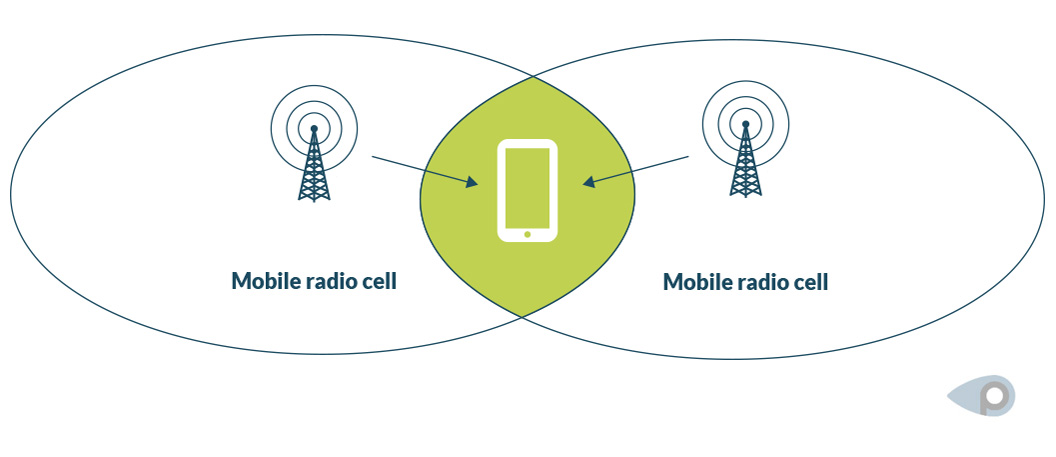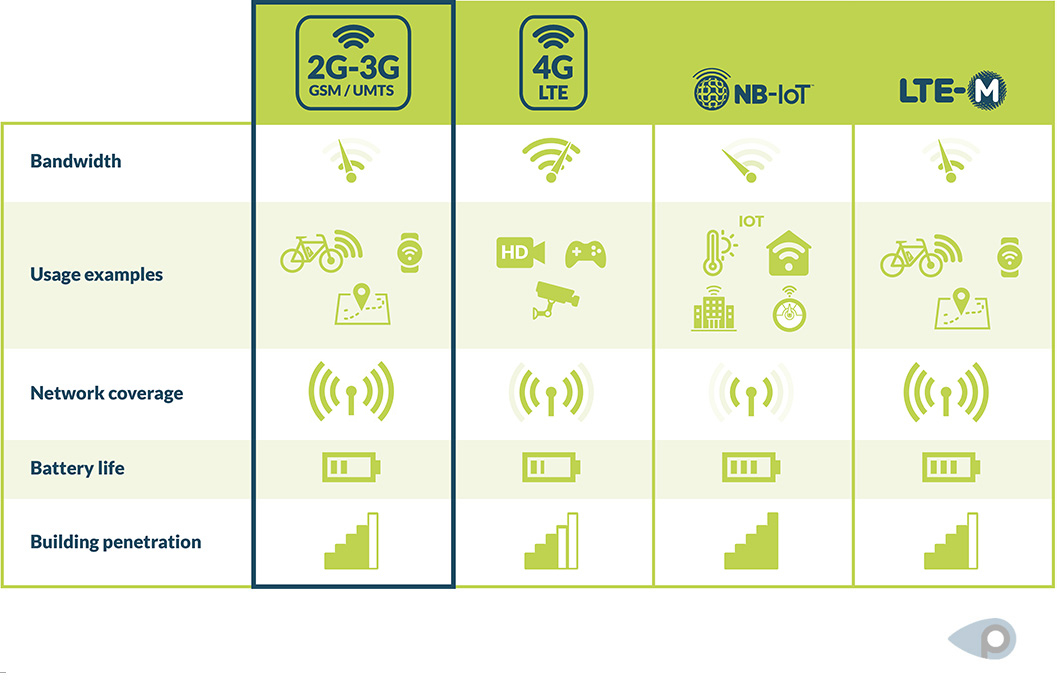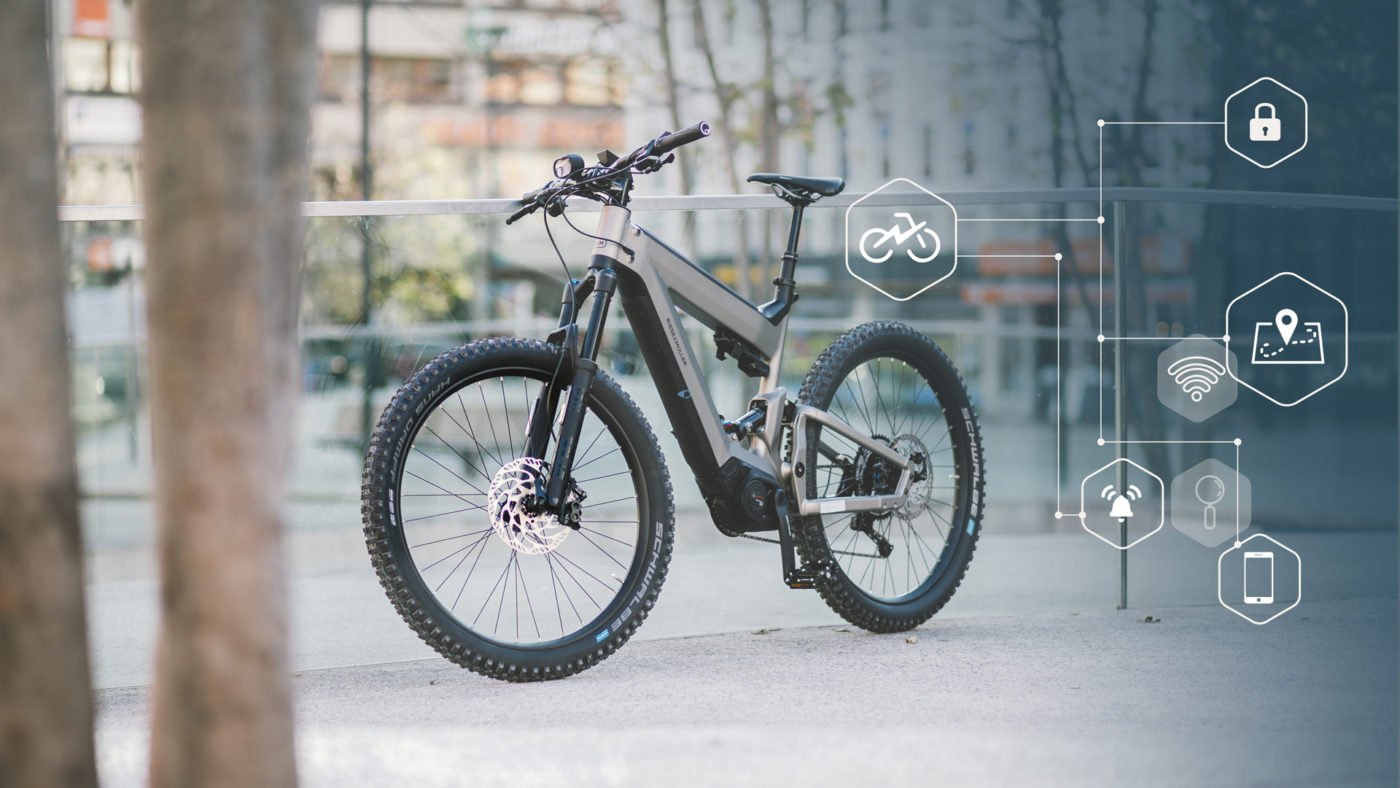- Free shipping from 220€The order of accessories (without BikeTrax) is excluded from the free shipping costs.
PowUnity explains, Special Topic, Topics
Narrowband IoT: The proper GPS tracker standard for your e-bike?
Inhalt
Narrowband-IoT in a nutshell
- Narrowband IoT (NB-IoT) is one of the Low Power Wide Area (LPWA) technologies.The wireless technology was specially developed for Internet-of-Things applications and combines a long range with good building penetration, a low bandwidth and low energy requirements.
- NB-IoT is well suited for some smart city applications, smart metering or tracking in logistics, for example.
- Due to the low network expansion and because narrowband IoT does not enable real-time tracking of mobile objects, the standard is not a good option for locating stolen bicycles or e-bikes. Here, 2G and, in the near future, LTE-M is the best choice.
NB-IoT and IoT – basics
Narrowband IoT – definition and characteristics
Narrowband is a colloquial term for low data transmission speed. The opposite of narrowband is broadband- high data transmission speed.
Narrowband IoT is a radio technology developed specifically for the Internet of Things and is being promoted by companies such as Deutsche Telekom. It is characterized by the following features:
- Low bandwidth
- High building penetration
- Low energy requirements
- Wide range
With these characteristics, NB-IoT belongs to the so-called Low Power Wide Area (LPWA) technologies. The basis for the technology is the 3GPP standard (3rd Generation Partnership Project). Such as LTE-M, NB-IoT uses the licensed frequency spectrum, or more precisely, the LTE network. This means it can be used with existing infrastructure.
What does Internet of Things mean?
The Internet of Things or IoT is the term used when physical objects are connected with each other and exchange information, for example, via sensors. In this context, machine to machine (M2M) is also important.
A well-known example of IoT applications are smart home applications. Smart home devices start with thermostats that automatically turn down the heating, extend to automated ventilation systems, and connected entertainment solutions. Cellular devices can also be part of the IoT. Tracking, for example, in logistics or theft protection, is also one of the widespread IoT applications.
The article “Internet of Things, bikes, and GPS tracking: the future is connected!” explains in detail what IoT is, what different application areas exist, and which technologies can be distinguished in the IoT area.
For which applications is Narrowband-IoT suitable?
Narrowband IoT was developed for the Internet of Things. However, not for all IoT applications, but specifically for those requiring a wide range, good building penetration, and low energy requirements.
This means, if technologies such as WLAN or EnOcean are used in smart home devices, NB-IoT is suitable for the following applications.
- Smart metering: With the help of NB-IoT, gas, water, or electricity meters regularly send data to the utility’s server.
- Checking filling levels: The NB-IoT standard is often used to check the fill levels of containers remotely.
- Smart cities:One of the smart city applications for which NB-IoT is suitable, is remote street lighting control.
- Tracking: In logistics, containers or wagons can be tracked with NB-IoT.
However, there are IoT applications that do not benefit from the advantages of NB-IoT. This applies not only to data-intensive smart home devices and entertainment applications but also to some tracking tasks in the IoT.
Narrowband IoT vs. other wireless technologies
In addition to NB-IoT, other radio standards are suitable for the Internet of Things and data exchange over long distances. In the following, we will look at the advantages and disadvantages of the existing technologies. We also discuss which standard is suitable for which applications, and where individual technologies reach their limits.
Narrowband IoT vs. LTE-M
LTE-M or LTE-Cat-M1 is the second new LPWAN – Low Power Wide Area Networks – alongside NB-IoT. At first glance, both standards are very similar; at second glance, significant differences reveal themselves:
- NB-IoT is characterized by better building penetration and power saving.
- LTE-M can transmit more data and enables real-time transmission due to lower latency (1). The standard also maintains connectivity when devices move from one cellular cell to another one (handover (2)). Neither of these applies to NB-IoT.

These differences mean that NB-IoT and LTE-M are suitable for various IoT applications:
- NB-IoT is mainly used for stationary devices. In addition, it is ideal for tracking as long as real-time data transmission is not required.
- LTE-M is suitable for real-time tracking (e.g., for theft protection). Since the standard is suitable for voice transmissions in the Internet of Things due to its high bandwidth, it is also used for emergency call functions (e.g., in elevators).
If you want to learn more about the LTE-M radio technology standard, the article “LTE-M – die neue Form der IoT-Technologie” offers you definitions, background information, and application examples.
Narrowband IoT vs. Sigfox and LoRa
The terms LoRa and Sigfox often come up in line with NB-IoT and LTE-M. These are two additional transmission standards developed for transmitting small amounts of data and focus on expanding the Internet of Things.
The most significant difference between NB-IoT and LTE-M and LoRa and Sigfox is that NB-IoT and 2G build on the same infrastructure, in which cellular technologies communicate as well. This means they share what is known as a licensed spectrum with established network providers. This infrastructure is constantly being expanded and today covers many applications of data transmission worldwide. In contrast, the providers of LoRa and Sigfox use their own developed and so-called “unlicensed” frequency spectrum.
However, these two technologies also differ in their properties and their areas of application:
- Sigfox’s network coverage is well advanced within Germany and globally, although it cannot match LTE-M or NB-IoT. The standard is used, for example, in the context of irrigation control, monitoring fill levels, or tracking suitcases.As an ultra-narrowband technology, Sigfox is characterized by extremely low bandwidth.
- Users of LoRa have to build their network infrastructure entirely themselves or work with local operators to do so. This makes the technology particularly suitable for locally limited projects. The advantage here is that control over sensitive data remains in the user’s hands. This is one reason why some utilities are relying on LoRa for smart metering (?).
The inadequate network coverage of LoRa and Sigfox is a deficit. It is not sufficient for optimal digital e-bike theft protection, which will not change in the future. Technologies that build on the licensed frequency spectrum and existing mobile radio standards will always have an advantage in network expansion.
Narrowband IoT vs. 2G
Now we come to an old acquaintance that still plays a significant role, especially in e-bike tracking: 2G.
Where does the name come from?
Mobile communication standards are divided into generations. 2G, 3G, and 4G thus stand for second-, third- and fourth-generation cellular standards. Within these generations, GPRS and LTE are the designations for data transmission. Thus, GPRS is the designation for data transmission within the 2G standard, and LTE is the designation for data transmission within the 4G standard. Simply explained: 2G and GPRS belong together, 4G and LTE belong together.
The 2G standard exists since the 1990s. This network transmits data extremely well and has no gaps. The main reason for the expansion to 3G and 4G is primarily the possibility of higher data transmission (bandwidth). While the 2G network was sufficient in the 1990s, since videos were not yet loaded via cell phones, the network was inevitably expanded to 4G with the introduction of the smartphone.
The 2G standard has the most comprehensive network coverage and is currently the best solution for tracking bicycles and e-bikes.
However, tracking a vehicle such as a bicycle, car, or e-bike does not require this high bandwidth. Data transmission rates of the 2G standard are absolutely sufficient. As the 2G network has existed since the 1990s, the network coverage is also correspondingly dense. Thus, you may no longer have 4G network reception in the field, but you will have 2G network reception.
Comparison of advantages and disadvantages of the different standards
- NB-IoT is excellent for small data transmissions and scores high on battery life and building penetration. For example, if machine data is transmitted in an urban area, then NB-IoT is ideal. After all, a machine is located in the basement of an urban industrial building with thick reinforced concrete walls. The connection is established once the devices do not move geographically and can transmit data such as machine temperature or filling levels without gaps.
- LTE-M suites well for real-time tracking and enables voice transmission. Energy consumption is still low, although not as low as NB-IoT. Even when objects are indoors, tracking works well.
- SigFox and LoRa cannot compete with NB-IoT in terms of network coverage, but they also have advantages, starting with the fact that there are no fees for frequency bands, and LoRa firmly owns the data. SigFox is also suitable for tracking in places where the proper networks exist.
- 2G will be replaced by LTE-M for real-time tracking of moving objects. However, the standard currently scores over LTE-M and NB-IoT with better network coverage. This is one of the crucial requirements in tracking theft protection.
Why narrowband IoT is not suitable for tracking a bicycle or e-bike
There are two key reasons why NB-IoT is not the first choice in GPS tracking for theft protection:
Lower network coverage.
NB-IoT builds on the LTE standard of the smartphone. Advantage: an already existing mobile communications infrastructure is used as a basis. However, to exploit this and make it suitable for narrowband IoT, it must first be upgraded. The upgrade takes time and is pushed faster in urban areas than in rural ones. The network coverage is also being expanded more quickly in certain countries (e.g., Germany) than in others.
For tracking bikes via NB-IoT, this is a disadvantage in 2021: In the Frankfurt area, for example, where the mobile network has already been upgraded to the NB-IoT standard, the network is sufficient. However, if the pedelec is stolen and taken to rural areas or abroad via the highway, the location of the bike or e-bike may no longer be transmitted. However, high building penetration and lower energy consumption are not needed if the stolen bike is lost in the radio hole of rural areas. Also, data such as daily routes cannot be recorded when I am cycling off-road and in nature.
No real-time tracking is possible.
Logistics service providers who want to tell their customers approximately where their package is located can use NB-IoT. The same is true if a company wants to determine the approximate location of goods.
When it comes to theft protection, however, real-time tracking is critical. It is the only way to know where your bike is. However, because of its high latencies and because the technology does not allow for handover, NB-IoT does not enable real-time tracking. That will not change in the future.
It follows: NB-IoT is not suitable for e-bike tracking, unlike LTE-M and 2G.
Transmission technologies in comparison

Bike and e-bike tracking: 2G as the optimal technology
Old but good: There are several reasons why PowUnity is currently relying on 2G as the radio standard for GPS tracking of e-bikes or motorcycles:
- No other standard, neither NT-IoT nor LTE-M, will reach a comparable network coverage until today in 2021 – whether in Germany or in other European countries. No matter where thieves transport your bike, with 2G, you have optimal chances of tracking it.
- The data transfer rate of 2G is low, but that does not matter for tracking.Only small amounts of data are sent anyway.
- 2G is also perfectly adequate for tracking connected objects in buildings. Therefore, it is no obstacle if a thief takes your e-bike into a basement or a storage building.
LTE-M or LTE-Cat-M1 will also be used in the PowUnity devices, no question. But only when the necessary infrastructure for the GPS trackers of the e-bikes is guaranteed. So that we can give our customers the same anti-theft guarantee as we do today with 2G technology.
Conclusion: NB-IoT is the standard of the future for stationary applications
Narrowband IoT has many advantages as a technology for the Internet of Things, from its low power consumption to licensed spectrum and existing network infrastructure.
Accordingly, the wireless standard will play a prominent role in the increasing connectivity of objects in everyday life.
However, there are areas of application for which NB-IoT is less suitable than LTE-M or currently still 2G. These include real-time tracking of mobile objects. Because of the comparatively high latencies and the fact that networked devices have to re-dial every time you switch to a new mobile cell, this will not change in the future.
The BikeTrax GPS tracker uses 2G technology to protect your e-bike. This is currently the best for this purpose.
That is why PowUnity does not rely on NB-IoT but on 2G. With GPS tracking, you benefit from seamless network coverage and real-time location transmission – the best prerequisites for locating your stolen e-bike at any time and getting it back with the help of the police. When the network for LTE-M or LTE-CAT M1 is ready – but only then – we will also switch so that you can constantly enjoy the best technology.We will leave NB-IoT, Sigfox, and LoRa to other providers with a clear conscience.
Share article!




 Deutsch
Deutsch